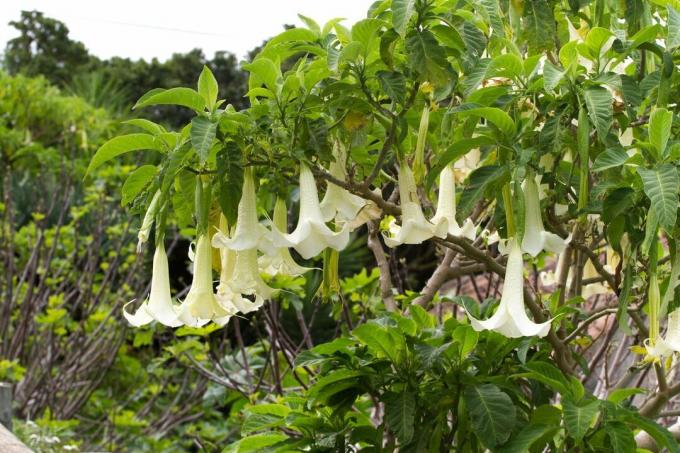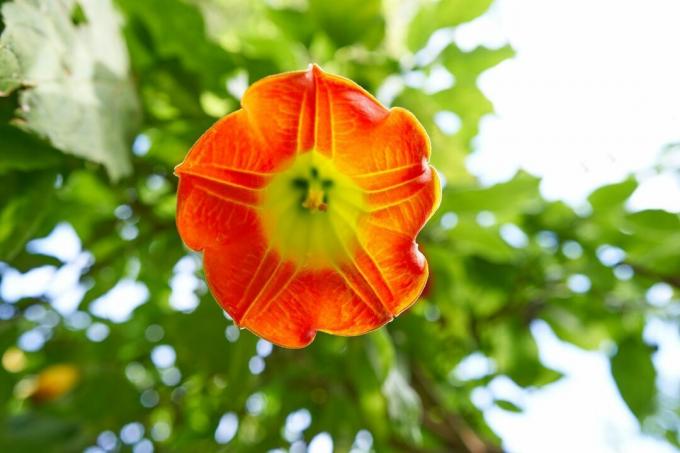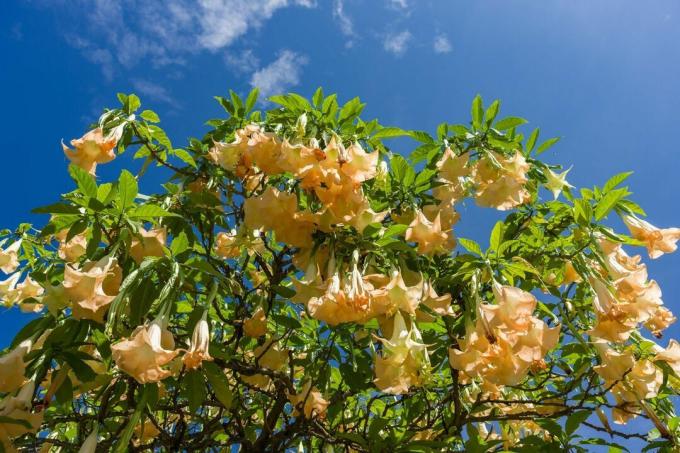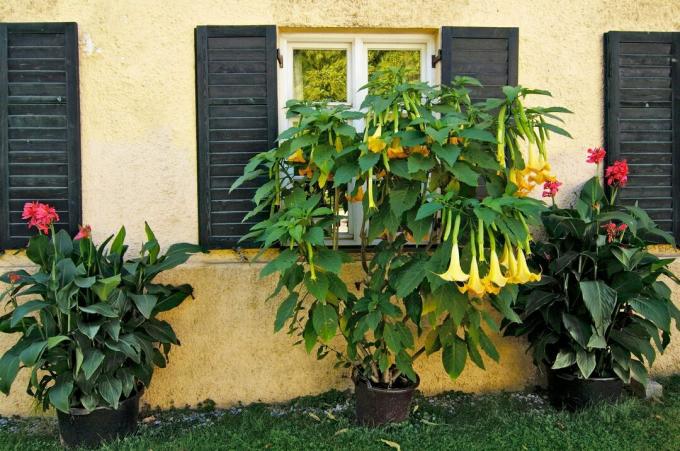Which location is best for angel trumpets (also Brugmansia or called trumpet plant)? Are angel trumpets hardy? We reveal everything to do with planting and caring for the angel's trumpet.

The loving name of this plant genus alone suggests how much admiration it is met with: angel trumpets (Brugmansia) are extremely popular ornamental plants. They are also very popular among collectors and breeders. The bush- or tree-shaped trumpet plants can be kept perfectly as container plants and beautify every home. Angel's trumpets not only delight with their splendor of flowers, but also give off a bewitching scent. However, this can only be heard in the late evening and night hours. You can find more exciting facts and care tips about the angel's trumpet in our detailed plant portrait.
contents
- Angel trumpets: flowering time, origin and characteristics
-
Angel trumpet types: Colorful angel trumpets for the garden
- White varieties of trumpet flower
- Red angel trumpets
- Purple angel trumpets
- Yellow angel trumpets
- Plant angel trumpets: location, soil & Co.
-
Angel Trumpet Care: Our Tips for Brugmansia
- Cut angel trumpets
- Fertilize angel trumpets
-
Increase angel trumpets
- Sow angel's trumpet seeds
- Propagate angel's trumpet by cuttings
- Hibernating angel's trumpet: is the trumpet plant hardy?
- Are angel trumpets poisonous?
- Common diseases and pests of the angel's trumpet
Angel trumpets: flowering time, origin and characteristics
The beautiful trumpet plants are not indigenous. They originally come from South America, where they thrive outdoors at a wide variety of altitudes. The angel's trumpet was introduced to Europe as an ornamental plant and is mainly kept there as a container plant due to the climatic conditions. In the Mediterranean area, some varieties can also survive in the wild. The tree- or shrub-shaped plants reach heights of between 2 and 5 meters and usually form hanging, calyx-shaped flowers. Flowering time, scent and color of the flowers vary greatly between the different varieties.

Angel trumpet types: Colorful angel trumpets for the garden
The genus Brugmansia includes numerous wild species and cultivated varieties. Not infrequently there are also hybrid forms that were bred from different species. Each variety has different properties and is therefore well suited for different types of husbandry. In the following, we present a colorful selection of brightly colored angel trumpets.
White varieties of trumpet flower
Belongs to the classic, white angel's trumpets Brugmansia arborea. This wild species originally comes from the Colombian Andes and is therefore quite a robust angel's trumpet. The plant has rather small flowers, about 15 cm long, which are less profuse, but bloom quite early in the year. In addition, this trumpet plant exudes a bewitching, floral scent.

Another white angel trumpet is the hybrid Brugmansia x candidathat are from the species Brugmansia versicolor and Brugmansia aurea was crossed. The "White Angel Trumpet" is a very strong and robust variety that can withstand bad weather conditions sometimes well. The crossbreed is therefore a very popular trumpet plant that is also well suited for beginners.
Red angel trumpets
Brugmansia sanguinea is originally from Colombia and Chile. The species smells very little, but beguiles with elongated, red flowers and is therefore also called the blood-colored angel's trumpet. A special feature of this variety is its flowering time: unlike other species, it blooms Brugmansia sanguinea rather late in the year and makes us happy over the winter with its blaze of color. However, this trumpet plant is less suitable for beginners, as it is quite susceptible to diseases and sensitive to moisture.

Purple angel trumpets
The hybrid Brugmansia x flava does not exude such a bewitching scent as its sisters. Instead, the variety enchants with long, tubular, dark-purple to red flowers that shine mainly in spring and autumn. However, since the hybrid is very susceptible to disease and incorrect maintenance, it is also more suitable for more experienced hobby gardeners.
Yellow angel trumpets
Brugmansia aurea is also called the golden angel's trumpet because of its mostly yellow, rarely white flowers. The species, originally from Ecuador, grows up to 6 m high, has large, bright flowers and exudes a pleasant scent. Unfortunately it will Brugmansia aurea we like to be attacked by pests.

Also the Brugmansia suaveolens Often shines in delicate or more intense yellow tones. With this species, the color is not always clear and can vary from white to yellow to pink. But it is very undemanding and well suited for beginners. In addition, the plant gives off a very intense smell and is therefore also called the fragrant angel's trumpet.

Plant angel trumpets: location, soil & Co.
Angel trumpets are frugal when it comes to the choice of location and earth. Basically any type of potting soil can be used. Since the trumpet plants have a high water requirement in summer and especially on hot days, a soil with good water storage and little cuttings is recommended. Many use a peat-rich soil for this. But think about this step carefully, because peat has a lot of questionable and polluting ones Properties: When the raw material is broken down, large amounts of carbon dioxide are released and valuable Destroyed ecosystems. You should therefore water a little more often on hot days and use a peat-free soil - such as ours Plantura organic potting soilthat are not only 100% peat-free, but also particularly sustainable and, compared to conventional soils, up to 60% CO2 is reduced.
Although many breeds tolerate direct sun well, angel trumpets thrive best in partial shade. The water loss on hot days can also be curbed there. Ideally, the plant is also protected from excessive weather conditions, as heavy rain and hail can quickly damage the sensitive leaves.

Angel trumpet care: Our tips for you Brugmansia
As mentioned, need Brugmansia a lot of water in summer. You should therefore water regularly, but avoid waterlogging. You will notice very quickly how much water your plant needs, because if there is a lack of water, the trumpet plants quickly let their leaves droop. This is not a problem, but it is a clear invitation to you to water more in the future.
Cut angel trumpets
Since the trumpet plants can grow several meters in size, it is advisable to prune the plants regularly. It is best to cut back your angel trumpets radically in the late year before wintering. The desired size of the plant should be determined very early, as only the new, still green branches should be cut off. The older, lignified areas, on the other hand, should be avoided, as otherwise growth at this point will be radically slowed down. Wear gloves as a precaution when cutting the poisonous plant.
Fertilize angel trumpets
All Brugmansia- Varieties need a lot of nutrients and therefore need to be fertilized regularly. The fertilizer application should begin at the beginning of the growth phase in March or April. A normal plant fertilizer can be used throughout the summer, or a special growth fertilizer can be added at the beginning. For a vigorous growth pattern and magnificent flowers, generous fertilization should be used - over-fertilization is almost not possible. Since the angel's trumpets prefer to be fertilized over the entire growth and flowering phase, a fertilizer with a long-term effect is also suitable - such as ours Plantura organic flower fertilizer. This mainly organic fertilizer not only guarantees a 3-month long-term supply, but is also sustainable, ecological and free from animal ingredients.
Increase angel trumpets
Angel's trumpets can be propagated via seeds as well as cuttings. However, the route via cuttings is the simpler one and therefore more suitable for beginners. In the following, we will tell you how you can succeed in increasing your favorite trumpets.
Sow angel's trumpet seeds
If you want to propagate your trumpet plant from seeds, you can collect them from the flowers and dry them over the winter. Here, however, you should be careful with hybrid varieties: you never know what properties the new plants will develop. The seeds can also be easily bought from specialist retailers. For sowing, the seeds first have to soak in water for 24 hours and can then be transferred to potting soil. Always keep the soil warm and moist afterwards. You can also cover the vessels with glass or transparent film, but make sure you air them regularly to prevent mold. The germination time can vary between a few weeks and 2 months depending on the variety and time of year.
Propagate angel's trumpet by cuttings
The propagation of angel trumpets via cuttings is possible throughout the summer. For this purpose, pieces about 10 cm in size are simply cut from the crown of the tree, the lowest leaves are removed and the stems are dipped about 4 cm deep in potting soil. Keep the cuttings in partial shade at around 20 ° C and moisten the soil without creating waterlogging. After 3 - 4 weeks enough roots should have formed so that the cuttings can be repotted. However, the pruning can also be used as cuttings in the late year and overwintered together with the mother plant. In this way enough roots should have formed in spring.
Hibernating angel's trumpet: is the trumpet plant hardy?
Angel trumpets are not hardy. That is also the reason why the beautiful ornamental plants are mainly kept in pots. The angel's trumpet can also be planted directly in the garden, but that makes the wintering process a little more complicated. As a container plant, the trumpet plant can easily be moved to suitable winter quarters, such as a garage or cellar. Pay attention to a minimum temperature of around 10 ° C. Also, water your angel's trumpet only about once a week in winter and avoid too much moisture. In order to prevent fungal infestation, adequate ventilation should also be aimed for.

Are angel trumpets poisonous?
Angel's trumpets belong to the nightshade family and, like many other plants in this group, contain poisonous alkaloids. This problem affects all parts of the plant, so gloves should be worn when pruning and food contact should be avoided. Consumption of the plant should also be avoided.
In some cultures it will be Brugmansia Also used as an intoxicant, as they are said to cause hallucinations and an ecstatic state. Since the wrong dosage can also lead to symptoms of intoxication here, it is also not advisable.
Common diseases and pests of the angel's trumpet
The more sensitive varieties of the angel's trumpet are particularly susceptible to viral or fungal diseases. The latter can be avoided with proper care and adequate ventilation at the site. But also predators such as caterpillars, aphids or snails like to tamper with angel trumpets. Grasshoppers leave particularly severe damage to their animals and should therefore be removed immediately.
As Fight aphids naturally and Get rid of snails you can find out in our special articles.


